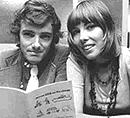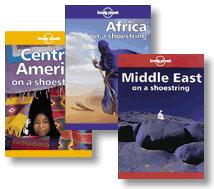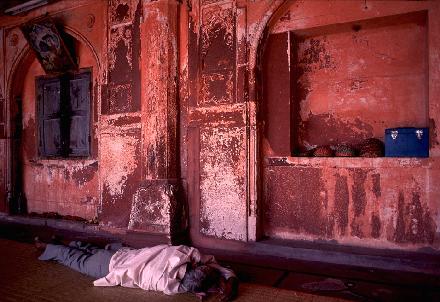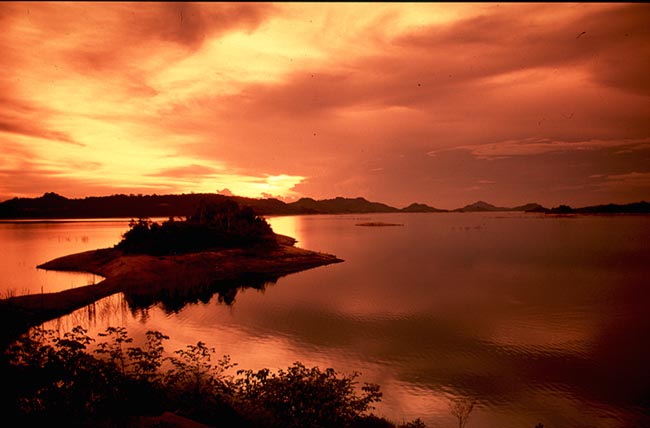Big bucks in backpacking
For a quarter of a century, Lonely Planet guides have covered the globe, telling budget travelers where to stay, what to eat, and practically to the penny, what to pay for it. In the process, the unconventional company has grown into a mega-business. Now the challenge, says founder Tony Wheeler, is keeping up with the times without losing LP's freewheeling charms
By Ron Gluckman /on the trail
H
E'S THE ULTIMATE ON-THE ROAD ICON, a modern Moses to legions of wanderers. For a quarter of a century, Lonely Planet founder Tony Wheeler has guided brigades of backpackers to a promised land of pristine beaches, mesmerizing mountain treks and endless platters of banana pancakes with muesli.Along the way, he's become the subject of scores of rumors, scion of a million complaints. The rumors detail his abandonment of backpacker ideals, or worse. Stories of his demise echo endlessly along the roads less traveled, and practically everyone seems to have some pet peeve with a Lonely Planet guide, particularly "Southeast Asia on a Shoestring."
Nonetheless, generations of grungy budget travelers have been introduced to Asia by that same yellow book, which backpackers refer to, in reverence or jest, as "The Bible."
In truth, Tony Wheeler isn't dead. Nor has he sold out. Far from it, in fact. He continues to travel widely and still writes guides, but he's assisted by several hundred employees in the vast Lonely Planet network. Now the world's largest independent guidebook publishing house, LP is still family-run by Wheeler and wife Maureen in Melbourne. The change has been in the scope and sophistication of a venture launched in 1973 in true backpacker style.
 After meeting on a park bench in London, the Wheelers took a honeymoon tour of
Asia. Frustrated by the information then available, they typed their notes and released
"Across Asia on the Cheap." A return visit and 18 months of serious road
research ended in a Singapore hotel, where they hand-stapled "Southeast Asia on a
Shoestring," the book that launched Lonely Planet and put Asia on the map.
After meeting on a park bench in London, the Wheelers took a honeymoon tour of
Asia. Frustrated by the information then available, they typed their notes and released
"Across Asia on the Cheap." A return visit and 18 months of serious road
research ended in a Singapore hotel, where they hand-stapled "Southeast Asia on a
Shoestring," the book that launched Lonely Planet and put Asia on the map.
That landmark guide has just reappeared in its 10th edition, timed to coincide with the 25th anniversary of the original release. The special edition features a fond overview of a quarter-century of Lonely Planet history, written by Tony Wheeler, including some photos from that first romp through Asia long ago.
Wheeler, 52, is a bit grayer, but hardly seems to have aged since riding a motorbike
around Asia in his late 20s, little realizing that the lark would become his lifelong
vocation. "I still travel half the year," he says. "I guess I get to pick
and choose more of where I go, and I don't have to worry about the bills these days."
Much has also changed for Lonely Planet, which maintains offices in London and Oakland (outside San Francisco), pulling in US$30 million in annual sales. Shoestring no more, LP sells millions of books each year from a catalogue that has swelled to 430 titles covering every corner of the planet. And LP has become the ultimate brand of independent travel, stamped upon diving and walking guides, phrasebooks, travel literature, atlases and, soon, new lines on healthy travel, food and restaurants.
LP has gone high-tech, too. A tie-in with internet search-engine Yahoo helps bring a million hits per day to the extensive Lonely Planet website. The company has just launched eKno, bundling long distance phone, email and internet-on-the-road services into one tiny plastic card. The kind no self-respecting Lonely Planet reader would have carried a generation ago.
But backpackers grow up. Yesterday's hippie in Katmandu is today's corporate executive in Hong Kong or Helsinki. Wheeler concedes that Lonely Planet has similarly matured. The company followed rival Rough Guides onto television and is presently retooling its printed guides into a format to fit the Palm Pilot for future executives on the go. Maureen has written about travel with children - the Wheelers have two, Tashi, 18 and Kieran, 16 - and a new line, "Read This First," will soon appear targeting first-time travelers.
"We are no longer guidebook publishers," Wheeler concedes. "We are travel information providers."
Yet, the mainstay of the company remains essentially unchanged. The LP niche has always been the back pocket of millions of youngsters who take to the road every year. More than any other guide, especially in Asia, they depend on Lonely Planet to tell them where to go, what to eat and, almost to the penny, what to pay.
It's a demanding task. "Being a great writer doesn't necessarily make a great travel writer," notes Wheeler, who guides scores of new authors and researchers each year through the time-tested Lonely Planet process. "It is very formula driven," he admits. "There's a bloody manual on how to write an LP book."
New writers come from all walks of life. Some have previous experience in travel or writing fields, or language skills. Yet there is no real LP role model. Robert Storey, a veteran of LP guides to Taiwan, Mongolia, China, Korea and Vietnam, was a slot machine repairman in Las Vegas, where he self-published his first book, "How to Do Your Own Divorce in Nevada." Based in Taiwan, he says, "Being a travel writer is not nearly as glamorous as it sounds. Most people think that I just go on holiday, have a great time, and then write about it.
"Reality is far different," adds Storey, who regularly puts in 12-16 hour days on the road. "I have no time for sightseeing. I spend my time on buses or trains, or else checking out hotels and restaurants. It's a tremendous amount of work."
Wheeler adds: "The biggest problem throughout our history has been burnout."
 The rewards come in recognition, particularly from accomplishing tough tasks,
like producing the first modern guide to Mongolia, which Storey did in 1992. He says:
"Lonely Planet got to be No 1 in this region because we were irreverent - we reported
about countries warts and all. Most of our competitors produced travel books about Asia
describing 'beautiful scenery and happy smiling peasants.' You wonder if the writers ever
got past the hotel lobby."
The rewards come in recognition, particularly from accomplishing tough tasks,
like producing the first modern guide to Mongolia, which Storey did in 1992. He says:
"Lonely Planet got to be No 1 in this region because we were irreverent - we reported
about countries warts and all. Most of our competitors produced travel books about Asia
describing 'beautiful scenery and happy smiling peasants.' You wonder if the writers ever
got past the hotel lobby."
Wheeler likewise takes pride in breaking new ground. Of hundreds of guides, the three he's most pleased with are guides to Southeast Asia, Burma and India. The latter, issued in 1981, may be the LP masterpiece. The massive India guide tackled an enormous, complex country, carving it into easily traversed sections, highlighting the attractions in each. It doesn't hurt that India is also a bargain for budget travelers. Not surprisingly, this is the best-selling guide in the entire LP collection.
"Burma also stands out for me," Wheeler says, "because it was the first book to really cover the country comprehensively. Being first always makes it more difficult to do the work. It's always easier to be second on the scene and build on what others have written."
The original guide to Burma was written by Joe Cummings, one of the first LP authors, and among the company's most active, still updating several titles each year. Among them is his thick guide to Thailand, which has won numerous awards. "I've made some silly remarks in guidebooks that I wish I'd hadn't," he says. "Fortunately, I get a chance every two years to revise what I've written in past editions." He bristles at cliched notions of LP authors as uninformed vagabonds. Cummings is a Lao and Thai scholar, fluent in both languages.
Lonely Planet didn't always draw on such experience. Wheeler himself wrote most of the guides in the 1970s, and many authors in the 1980s complained of barely covering their expenses. Budgets for guidebooks now run to six-figure sums, often split among a half dozen or more authors. As the recompense has grown, so has the stature of Lonely Planet among fellow travelers.
In some ways, it's pleasing. Many authors bask in the glory, while others try to avoid the annoyance of celebrity status among backpackers as a Lonely Planet legend. I've been with him in Laos and was amazed at Cummings' preference - and ability - to travel incognito.
As a result, he's heard countless versions of his own death. Unsettling, but no more so than coming face-to-face with someone posing as a Joe Cummings imposter. His biggest gripe? "The way people think your guidebooks have some kind of vast influence on the travel world. Simply because lots of people carry the guides, this is the assumption, but it's largely fallacious. I've come to the conclusion that although people purchase and carry these guides as a kind of security blanket, travel trends as a whole are set by word of mouth."
He takes issue with the criticism in Alex Garland's bestseller "The Beach," soon to be a movie starring Leo diCaprio. In his utopian novel about the search for a perfect beach in Thailand, Garland wrote: "There's no way you can keep it out of the Lonely Planet, and once that happens, it's countdown to doomsday."
Cummings chuckles as he retorts: "Yes, a few people treat the books like they're the holy scriptures, but those folks are, I believe, in the blessed minority."
Lonely Planet is well aware of the downside of tourism, which often seems to threaten the very qualities of environmental beauty or cultural uniqueness that drew visitors to these formerly-wonderful, now-overrun places. The company has long donated a portion of its profit to preservation groups working in the places it writes about. The upside is tourism brings opportunities, even in the most depressed areas of the world.
 "Travel has its negative aspects but
it's still one of the cleanest industries going," says Cummings. "Besides, I'd
rather see hotels on Phuket than tin mines, rather see scuba divers in the Andaman than
coral dynamiting. Without an economic incentive, very little of the natural world gets
preserved."
"Travel has its negative aspects but
it's still one of the cleanest industries going," says Cummings. "Besides, I'd
rather see hotels on Phuket than tin mines, rather see scuba divers in the Andaman than
coral dynamiting. Without an economic incentive, very little of the natural world gets
preserved."
Another criticism leveled at Lonely Planet is that while the guides have made the globe easier to traverse, they have left fewer places untrammeled. Cummings counters that most people who buy the books never put them to use; the vast majority are armchair travelers. In any case, Wheeler thinks his homegrown company's influence is overrated. "I don't think Singapore Airlines buys new jumbos just because we did 'Southeast Asia on a Shoestring'," he quips.
Nonetheless, the accolades continue to pile up. Travel and Leisure magazine recently named Wheeler as among those who have most changed the way the world travels. Indeed, if anyone can be credited with converting the hippie trail across Asia into a tourism superhighway, he's the man.
Surprisingly, after all these books (he wrote a large number himself during the lean times in the 1970s and 1980s) and so many miles, Wheeler still hasn't fallen victim to the guidebook author's great nemesis: burn out. Far from it, in fact.
He's recently been to the South Pacific, Syria and Lebanon. Last year, his loving tribute to human transport, "Chasing Rickshaws," launched an LP line of coffee table photo books. Another on the Asian staple, rice, has taken Wheeler on a whirlwind tour of the Philippines, Cambodia, Vietnam, Indonesia and Burma. And his name will be on forthcoming Diving and Snorkeling guides to Victoria, Australia, and Tahiti and French Polynesia.
Not that it's always been a smooth path around the Lonely Planet. Wheeler can recount road nightmares all night. In fact, he's just put together a book of Travel Disaster Stories ("Unpacked") that collects the worst travel tales from the LP staff.
Yet the guidebook guru himself rarely gripes. "I'm still traveling half the year, and I still love it," Wheeler explains. "I get to go a lot of different places and see lots of different things. Who'd complain about that?"
Ron Gluckman is an American reporter who is based in Hong Kong, but who roams around Asia for a number of publications, such as Far Eastern Economic Review, which ran a much different version of this LP story in October 1999. Ron has traveled with Lonely Planet writers in Mongolia, China, North Korea and Laos, and introduced several to the pleasures of the People's Republic of Lamma Island.
Photo credits: The top two photos on this page are courtesy of Lonely Planet; the bottom photo is by David Paul Morris, a frequent partner whose work can be sampled throughout this site; the India photo and all others on the site (unless otherwise credited) can be blamed on Ron Gluckman
To return to the opening page and index
push here
[right.htm]
